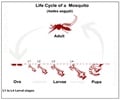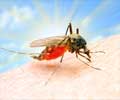
The researchers, led by Michael G. Rossmann, Hanley Distinguished Professor of Biological Sciences, found that the dengue virus particles swell slightly and take on a bumpy appearance when heated to human body temperature, exposing "epitopes," or regions where antibodies could attach to neutralize the virus.
The discovery is significant because it could help to explain why vaccines against dengue have been ineffective, said Michael G. Rossmann, Hanley Distinguished Professor of Biological Sciences at Purdue University.
Scientists have been designing vaccines targeting the virus's smooth appearance found at the cooler temperatures of mosquitoes and ticks.
"The bumpy form of the virus would be the form present in humans, so the optimal dengue virus vaccines should induce antibodies that preferentially recognize epitopes exposed in that form," Rossmann said.
The researchers used a technique called cryo-electron microscopy to see the three-dimensional structure of the virus at temperatures ranging from 28-37 degrees Celsius (37 degrees Celsius is 98.6 degrees Fahrenheit, or human body temperature). Findings showed that the virus has a smooth appearance while at the cooler temperatures found in mosquito or tick vectors, but then it morphs into the bumpy form at warmer temperatures before fusing to the host cell and delivering its genetic material.
Advertisement
Findings also could apply to related infections in the flavivirus family, which includes a number of dangerous insect-borne diseases such as West Nile, yellow fever, tick-borne encephalitis and Japanese encephalitis.
Advertisement
The team was able to measure the virus's infectivity using a laboratory procedure where cells are infected in a culture dish. The bumpy shape is an intermediate stage before the virus becomes unstable, releasing its genetic material. The virus is made of subunit molecules that separate when the virus particle expands into its bumpy form, revealing exposed membrane surfaces between the subunits where antibodies might bind.
The findings are detailed in a research paper appearing online this week in Proceedings of the National Academy of Sciences.
Source-ANI












